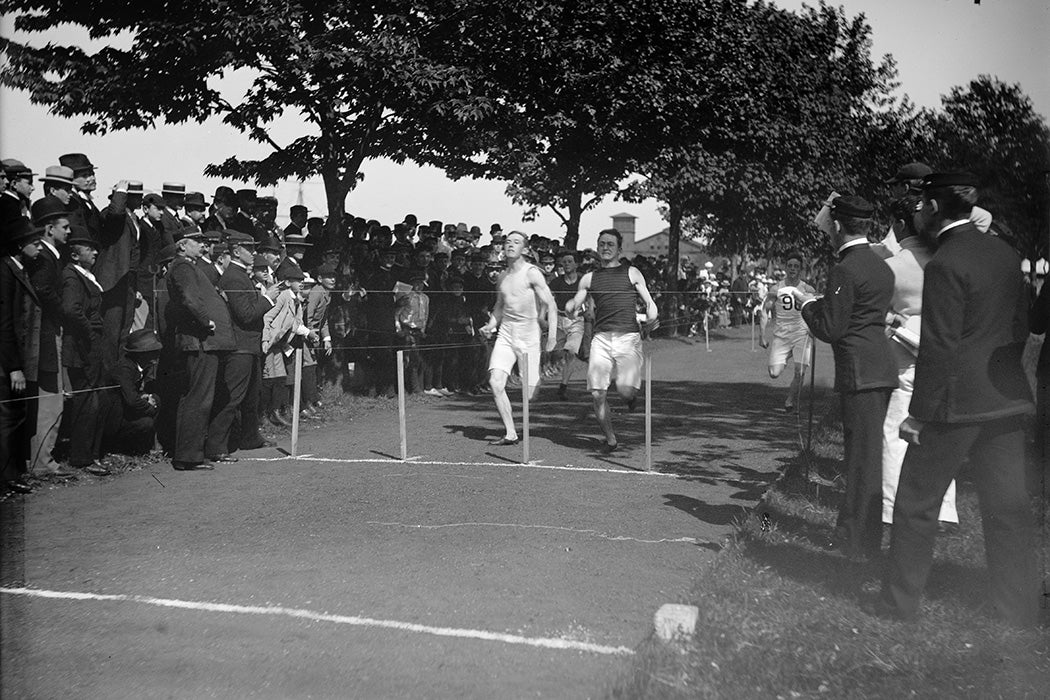Like so many other activities, sports follow trends. What might have been popular in one era, fades away in the next. After all, cricket was as popular in the US as baseball in the 1800s. Even running has seen its fair share of changes. In the nineteenth century, professional running had a “reputation for deception,” explains librarian Lisa R. Lindell. It “was subject to trickery and race fixing and rewarding of those athletes who worked the system to their advantage.” That era of the sport—with all of its possible shenanigans—is illustrated in the life of James “Cuckoo” Collins.
“Running, walking, and jumping competitions, known collectively as pedestrianism, were among the most popular sporting events,” Lindell explains. But like many sports of the time, pedestrianism was full of gambling. Maximizing those winnings, which would also be enjoyed by the racer, usually meant a little bit of trickery. Runners often collaborated with each other and coaches to fix races, making the outcomes financially determined rather than athletically. American racers “would starve to death if they were honest,” a sprinter once claimed.
Collins’s professional career started when he began training with John Kline, an athlete and trainer with an international reputation for his work. Clients of Kline’s gym followed a strict diet and a “rigorous program that included running, wrestling, weightlifting, and boxing.” Collins soon gained a reputation himself for his sprinting abilities, and he began competing on the national stage. He won races across the country, sometimes under an assumed name, a common deception practiced by runners at the time, as those “known for their swiftness or for their craftiness could lower expectations or deflect suspicions.”
And Collins was known for his craftiness. According to his hometown newspaper, his nickname, “Cuckoo,” was a testament to his skills in trickery.
Collins colluded to lose races, ensuring that the only winners would be those who bet against him. He also went the other direction, using a fake name to enter races and “overtook local favorites for the win.” Collins’s antics often made the local papers, but he was hardly alone. The accusations of cheating were so prevalent, a group of sprinters created the Professional Athletic Association of America in 1888 to “bring a degree of organization and respectability to their sport,” Lindell writes.
Collins continued in his own, familiar way, though. But one race in particular, against a runner who used all of Collins’ tricks against him, changed everything.
In 1893, bar owner Patrick Dolan backed Collins in a 100-yard race. Dolan placed his money on an easy Collins win against a local runner. The race wasn’t so easy, however, as it turned out that the local amateur was actually “a noted Scottish runner working as a ‘ringer.’” Dolan lost his money. Furious, and not unreasonably suspecting Collins of throwing the race, Dolan shot the defeated runner.
Weekly Newsletter
Collins survived the shooting, but professional running didn’t. “By the early twentieth century,” Lindell writes. “The era of professional sprinting was seen as a bygone time.” Amateur running had taken over, and earning money for competing became a thing of the past—as did the sport’s popularity. The public’s interest shifted to “sports like football and cycling, and running’s focus shifted to universities and colleges and to international competition.”
Even more than his exploits, which included heists, cons, and even a prison escape, Collins’s career is a stand-in for the trajectory of running as a sport, Lindell explains. It “illumines both the opportunities and the excesses and provides a context for understanding how these elements were interwoven into the arc of the sport.”







